The power system is undergoing transformation, with magnetic integration technology becoming a key breakthrough point? Professor Wang Ningning shared at the academic annual meeting how the new packaging substrate integration technology will lead the innovation of power technology.
Cover | Electronic Transformer and Inductor Network
At the 11th Joint Academic Annual Meeting of Power Converters Magnetic Components in 2024, Vice Chairman of the Magnetic Technology Professional Committee of the China Power Supply Society, Professor Wang Ningning from Hangzhou University of Electronic Science and Technology delivered an exciting speech titled “New Packaging Substrate Integration Technology”.
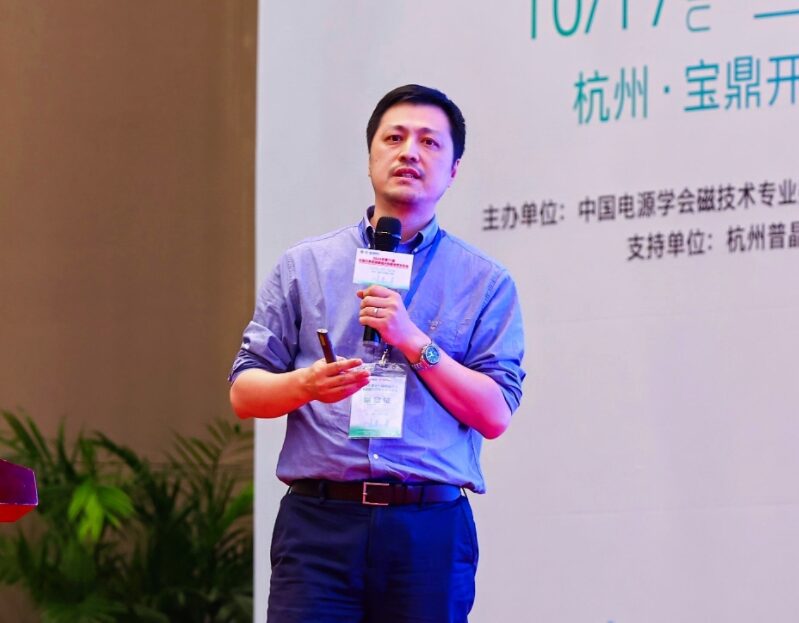 Professor Wang Ningning
With the rapid development of digital processing chips such as CPUs, GPUs, and FPGAs, the power system is undergoing an unprecedented transformation. In this context, Professor Wang Ningning’s speech and the subsequent interview not only have theoretical value but also provide guidance for industrial practice.
After the meeting, Professor Wang accepted an interview with reporters from the Electronic Transformer and Inductor Network, where he discussed topics such as the future development of inductors, technology applications, and industrialization challenges.
Transformation of Power Systems: Why is Magnetic Integration Technology Key?
With the trend of vertical power supply development, traditional power systems are gradually transforming towards miniaturization, lightness, high frequency, and integration to meet the growing power supply demands of digital processing chips like CPUs, GPUs, and FPGAs.
The trend of multi-core digital processing chips not only enhances computing power but also imposes more refined requirements on power management, aiming to improve energy management efficiency, extend battery life, or reduce power consumption.
Currently, the power supply system is still dominated by board-level power supply, where the power transmission path is crucial to power efficiency and performance, especially in terms of current change rate (DI/DT) and output voltage stability. Therefore, reducing the losses and self-impedance of the power distribution network (PDN) path has become a key problem that needs to be solved in the power supply field.
Technological evolution has led to profound changes in power architecture, transitioning from the traditional 12V to a low-voltage power supply mode of 1-5V, gradually shifting to a low-voltage bus architecture of 48V to 1.55-3.3V. This architecture provides the possibility of powering digital chips through a low-voltage bus, enabling on-chip power (IVR) or fully integrated power (FIVR).
Professor Wang Ningning
With the rapid development of digital processing chips such as CPUs, GPUs, and FPGAs, the power system is undergoing an unprecedented transformation. In this context, Professor Wang Ningning’s speech and the subsequent interview not only have theoretical value but also provide guidance for industrial practice.
After the meeting, Professor Wang accepted an interview with reporters from the Electronic Transformer and Inductor Network, where he discussed topics such as the future development of inductors, technology applications, and industrialization challenges.
Transformation of Power Systems: Why is Magnetic Integration Technology Key?
With the trend of vertical power supply development, traditional power systems are gradually transforming towards miniaturization, lightness, high frequency, and integration to meet the growing power supply demands of digital processing chips like CPUs, GPUs, and FPGAs.
The trend of multi-core digital processing chips not only enhances computing power but also imposes more refined requirements on power management, aiming to improve energy management efficiency, extend battery life, or reduce power consumption.
Currently, the power supply system is still dominated by board-level power supply, where the power transmission path is crucial to power efficiency and performance, especially in terms of current change rate (DI/DT) and output voltage stability. Therefore, reducing the losses and self-impedance of the power distribution network (PDN) path has become a key problem that needs to be solved in the power supply field.
Technological evolution has led to profound changes in power architecture, transitioning from the traditional 12V to a low-voltage power supply mode of 1-5V, gradually shifting to a low-voltage bus architecture of 48V to 1.55-3.3V. This architecture provides the possibility of powering digital chips through a low-voltage bus, enabling on-chip power (IVR) or fully integrated power (FIVR).
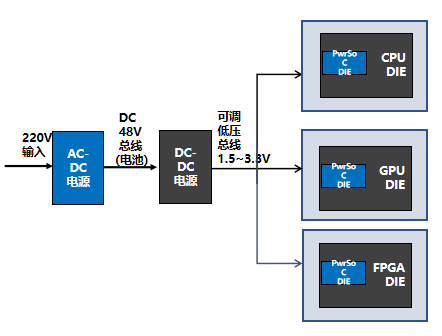
Fully Integrated Power Supplies Have Significant Advantages.
First, using micro-nano processing or packaging technology, passive components such as inductors and capacitors are integrated into a single chip, greatly reducing the power supply area and height, which can be placed inside the load package or on its backplane, thus significantly shortening the PDN path;
Secondly, the increased granularity of power supplies allows a single power supply to be decomposed into dozens or even hundreds of independently controlled small power supplies, each of which can perform independent voltage control, achieving more refined voltage management;
Furthermore, the enhanced dynamic response and reduced PDN conduction losses significantly improve system efficiency.
However, high frequency, high efficiency, as well as the integration and miniaturization of magnetic components remain the main challenges faced by current power design. How to achieve the miniaturization and integration of magnetic components while maintaining high performance has become a focal point of industry attention.
New Developments in Magnetic Components: Packaging Substrate Magnetic Integration Technology
In traditional board-level power design, independent components such as inductors, capacitors, and controllers are commonly used.
However, with continuous technological advancements, a revolutionary change emerged in the market about a decade ago—inductors were cleverly embedded into the chip packaging, significantly reducing the area of the circuit board.
This trend has not stopped; in recent years, we have witnessed the simultaneous integration of inductors and capacitors into the package, which has further promoted the reduction of power supply area.
Ultimately, an ideal vision is gradually being realized: integrating the power control circuit, power devices, magnetic components, and capacitors all on the same silicon chip, forming what is known as “on-chip integrated power supply”.
Although this technology holds great potential, its development process still faces many challenges, requiring more innovation and breakthroughs.
In the field of magnetic component integration technology, we have also witnessed the evolution from wound magnetic components, planar magnetic components, to PCB integrated magnetic components, and even silicon integrated magnetic components. This series of developments has not only improved the performance of magnetic components but also provided a solid foundation for the integration of power systems.
Meanwhile, embedded packaging substrates in packaging integration technology and the associated magnetic integration technology demonstrate excellent application potential.
Packaging Integrated Power Supplies greatly reduce the space occupied by power systems by integrating passive components such as inductors and capacitors with control chips within the same package.
On-chip integrated power supply, as the ultimate goal of power technology, requires the integration of all passive components and control chips into a single chip at higher frequencies, which undoubtedly poses a significant challenge to current technology.
In the practical exploration of packaging integrated power supplies, various integration methods and forms have emerged, each with its own characteristics in terms of frequency response, process complexity, supply chain maturity, and development cycle.
For example, silicon-based integrated power supplies are known for their high precision and flexibility, but the corresponding equipment requirements and process complexity are also high; while PCB integrated power supplies are favored for their simple processes, mature supply chains, and short development cycles, yet they have certain limitations in terms of integration and precision.
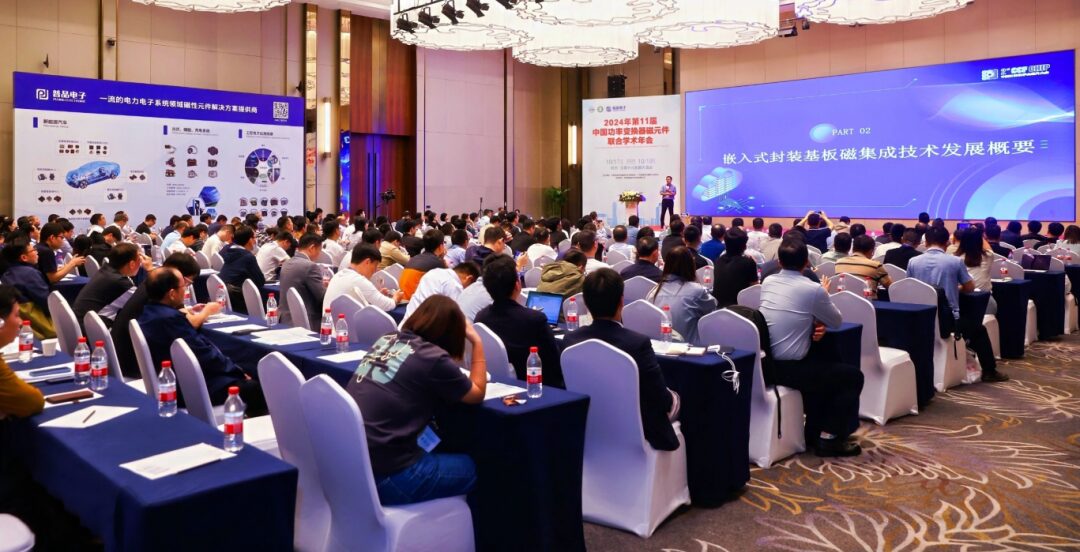
Professor Wang Ningning delivering a speech at the academic annual meeting
In industry practice, tech giants like Intel are also actively exploring different technological paths. One solution is to use air core inductors, which, due to their small inductance and operating frequencies of up to 100MHz to 140MHz, achieve efficient, high-frequency applications of fully integrated power supplies.
Another solution combines the magnetic core structure with PCB technology, by drilling holes in the PCB substrate and filling them with magnetic powder cores to form a single-turn inductor structure, effectively achieving vertical power supply.
Although this structure has relatively low inductance and is limited by processes and materials, with a magnetic core permeability of only 8.5, it is still applicable for higher frequency switch power supplies, such as 90MHz to 100MHz.
However, this technology also faces some challenges. The thickness of the PCB is relatively thick, and the filler is prone to cracking during the lamination process, affecting the reliability of the product.
Moreover, due to process limitations, it is difficult to reduce the height of the inductor, especially when the design relies on height to achieve sufficient inductance. Therefore, in existing solutions, the size of the PCB generally exceeds 1.0mm.
Professor Wang Ningning’s Team: Exploring the Challenges and Innovations of Packaging Substrate Magnetic Integration
In response to the above issues, Professor Wang Ningning and his team have conducted extensive exploratory work. They attempted to create intermediate vias in PCBs, where the upper and lower wires are still made through PCB, but the middle is excavated to place different magnetic materials, such as film materials or powder core materials.
The researchers created two types of magnetic cores: iron-silicon-aluminum powder cores and nickel-iron films.
The iron-silicon-aluminum powder core is heat-pressed into blocks after surface treatment with an insulating layer, then cut into thin slices and placed in PCB holes; the nickel-iron film is made using electroplating methods on a PI substrate, and multilayer lamination is cut and filled into holes.
These two types of inductors exhibit different characteristics:
The iron-silicon-aluminum powder core has good high-frequency characteristics, with a Q value of up to 36, suitable for frequency ranges of 50MHz to 100MHz; while the nickel-iron film has higher inductance but higher eddy currents at high frequencies, with a relatively low Q value of about 16.
To reduce PCB thickness, they adopted thinner processes, using 6-micron nickel-iron alloy materials, which were bonded and heat-pressed into multilayer films, then cut into small pieces and placed into PCB holes.
The inductors made using this method have characteristics similar to previous film inductors, with inductance between 20 to 30 nanohenries, Q values in the teens, and thickness significantly thinner than the previous drilling method, with a total thickness of less than 0.4mm.
The research team also attempted to make magnetic films into sheets and integrate them with PCB processes. They first stacked and patterned the magnetic films, then filled the holes with glue. This method can further reduce the reserved safety distance and form thinner flexible board integrated inductors through normal PCB processes.
They used PI films and electroplated on both sides, controlling thickness to around 2 microns to further improve high-frequency performance.
The results show that at tens of megahertz, the inductance decreases while the Q value significantly increases, reaching around 20, and the frequency at which the Q value occurs increases to 15 megahertz.
The research team compared flexible boards or ultra-thin PCBs with previous work and found that within the working range of 10MHz to 20MHz, the Q value remains competitive.
However, due to the lack of high-precision packaging substrate processes, the inductor density is relatively low. If more precise packaging substrate processes are adopted, the area can be greatly reduced, and the inductor density can be higher.
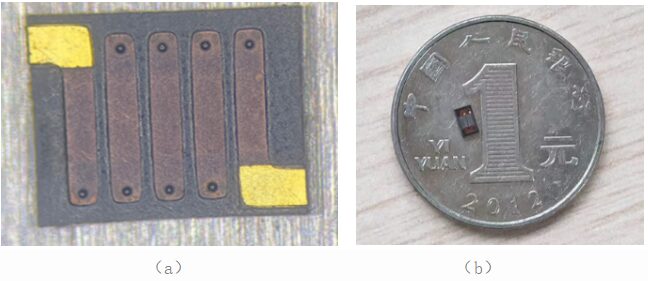 Magnetic integrated devices: (a) Packaging substrate integrated inductor (b) Silicon-based integrated inductor
Magnetic integrated devices: (a) Packaging substrate integrated inductor (b) Silicon-based integrated inductor
Additionally, the research team has also explored excavating holes for impedance testing under high-frequency signals and attempted to extract the losses of magnetic cores.
They found that traditional ring-shaped sample testing methods are not suitable for thin film materials with various shapes, thus the PCB-based method provides a new idea for testing the losses of thin film magnetic cores.
Currently, Professor Wang Ningning and his research team can accurately test the losses of thin film magnetic cores in the range of 10MHz to 60MHz.
Professor Wang Ningning believes that in terms of future development and challenges, the research and large-scale preparation of high-frequency ultra-low loss films/powder cores, high-frequency loss testing of soft magnetic film materials, efficient magnetic component integration process technology, precise mathematical models for high-frequency inductors, and overall packaging technology for power systems are urgent issues that need to be addressed.
Interview Highlights: Future Prospects for Industrialization of Packaging Substrate Magnetic Integration
In his speech, Professor Wang profoundly analyzed the challenges faced by the transformation of power systems and fully integrated power supplies in an easy-to-understand manner, introduced the latest progress in embedded packaging substrate magnetic integration technology, and forecasted the future development trends of silicon-based magnetic integrated devices, providing deep insights and inspiration to the magnetic component companies present.
Everyone showed great enthusiasm and curiosity about the future application scenarios of this technology and the potential challenges in its industrialization. Based on this, reporters from the Electronic Transformer and Inductor Network specially invited Professor Wang for an interview, where he answered in detail the concerns of industry enterprises.
Reporter: What technical research are you currently doing regarding the future development of inductors?
Wang Ningning:We are currently researching two types of technologies: packaging integrated inductors and silicon-based inductors. Packaging integrated inductors integrate inductors and other passive components with connection lines and structural parts to form a complete packaging integration solution.
On the other hand, silicon-based inductors grow wires, magnetic core materials, insulation layers, etc., directly on top of control chips through thin film growth and other micro-nano processes, achieving on-chip power integration.
Reporter: What is your view on air inductors as a future development trend?
Wang Ningning:I believe that air inductors do have certain advantages in some scenarios, such as being easier to implement and having a relatively complete industrial chain. However, as a power designer or application party, we will still choose the most suitable inductor solution based on specific needs.
Air inductors may have some performance losses, so we need to weigh the pros and cons to make decisions. At the same time, with continuous technological advances and the maturity of the industrial chain, more and better inductor solutions may emerge in the future.
Reporter: In which areas do you think the technology solutions you shared can be applied in the future?
Wang Ningning:We are not yet fully engaged in product manufacturing; we are only exploring technology in this area. From our current research, the technology is feasible. If we truly want to implement this solution for large-scale production in the future, the entire industrial chain of this packaging substrate solution will be relatively complete.
Moreover, from the perspective of the entire development process, if the future supply chain is complete, the product development cycle will be relatively shorter.
Although we do not have specific products right now, I can say that this technology can be used to power AI chips or other digital processing chips like CPUs and GPUs that require high power density, high efficiency, and have space limitations for power supplies. Such products can all utilize our technology.
Reporter: What do you think are the main technical challenges faced by companies in the process of industrialization?
Wang Ningning:I think the main challenges lie in the maturity of the technology and the ability to integrate the industrial chain. Although some technologies look promising, a mature industrial chain and solutions have not yet been formed.
This requires companies to have strong R&D capabilities and resource integration capabilities to promote the industrialization and application of technology. At the same time, domestic companies generally hold a cautious attitude towards new technologies and are reluctant to be the first to try.
Reporter: I heard that your research team has already cooperated with companies. Can you reveal which companies they are?
Wang Ningning:Of course. We have collaborations with companies like OPPO and China Electronics Corporation. These collaborations allow us to better transform research results into practical applications and provide strong support for the innovative development of these companies, for which we also express our heartfelt gratitude.
Reporter: Can you share the next research direction or core goals?
Wang Ningning:Our current research direction is two-pronged: on one hand, we continue to advance research and application for packaging integrated inductors, providing technical support for the integration of inductors in vertical power supply and module power systems; on the other hand, we are actively exploring silicon-based inductors to provide solutions for ultimately achieving on-chip integrated power supplies.
Professor Wang Ningning and his research team have achieved significant research results in packaging integrated inductors and silicon-based inductors. These results not only provide strong support for the innovation of power technology but also offer feasible solutions for the power supply needs of future high-performance chips.
Companies need to focus on technological innovation, ensuring high performance while achieving the miniaturization and integration of magnetic components. At the same time, they must balance supply chain maturity, process complexity, and development cycles, strengthen cooperation between industry, academia, and research, and transform research results into practical applications to meet the higher demands for power systems in AI, high-performance computing, and other fields.
In the future, power technology will continue to innovate, and the industrialization and application of magnetic component technology will inject new momentum into technological development.
Facing the trends of miniaturization, high frequency, and integration of power systems, what do you think is the biggest challenge currently facing magnetic integration technology?
Has the new packaging substrate integration technology proposed by Professor Wang Ningning provided you with new ideas or solutions for your R&D work? We welcome you to share your views and experiences!
This article is an original piece by the Electronic Transformer and Inductor Network, and may not be reproduced without permission. Otherwise, legal responsibility will be strictly pursued.
Click to follow and learn more about electronic transformer and inductor news
— Previous Recommendations —
Looking forward to your support~
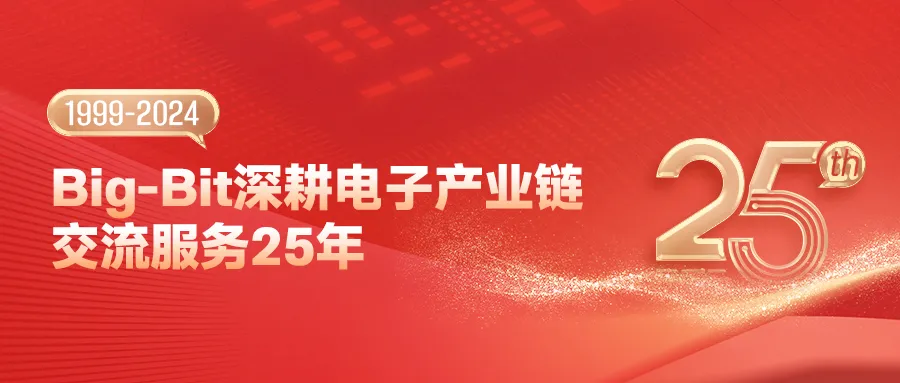
 Professor Wang Ningning
Professor Wang Ningning

 Magnetic integrated devices: (a) Packaging substrate integrated inductor (b) Silicon-based integrated inductor
Magnetic integrated devices: (a) Packaging substrate integrated inductor (b) Silicon-based integrated inductor


